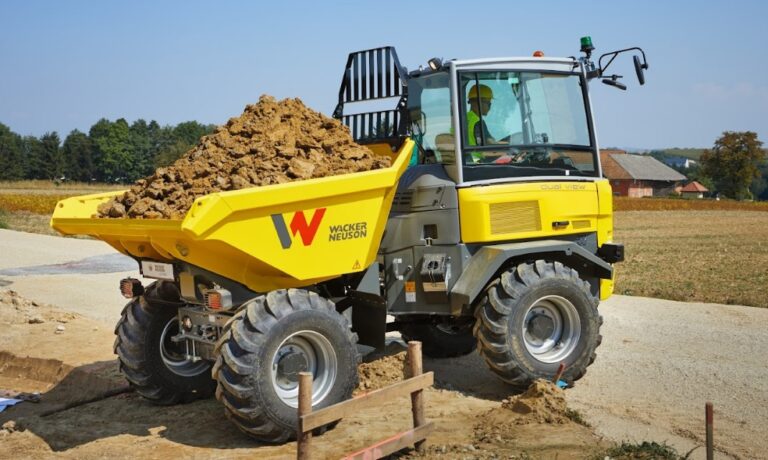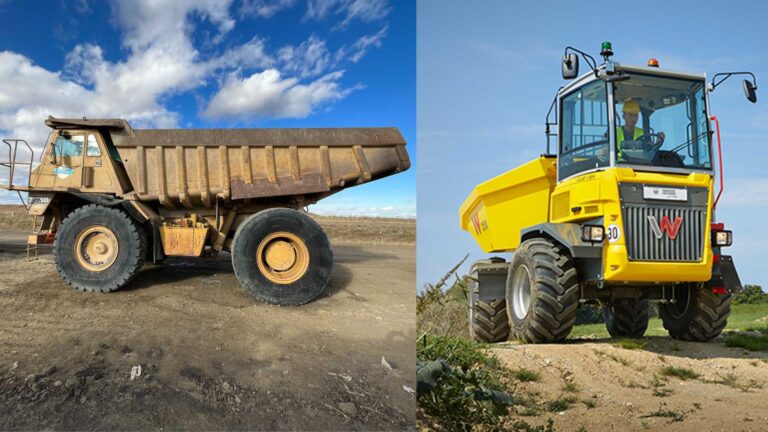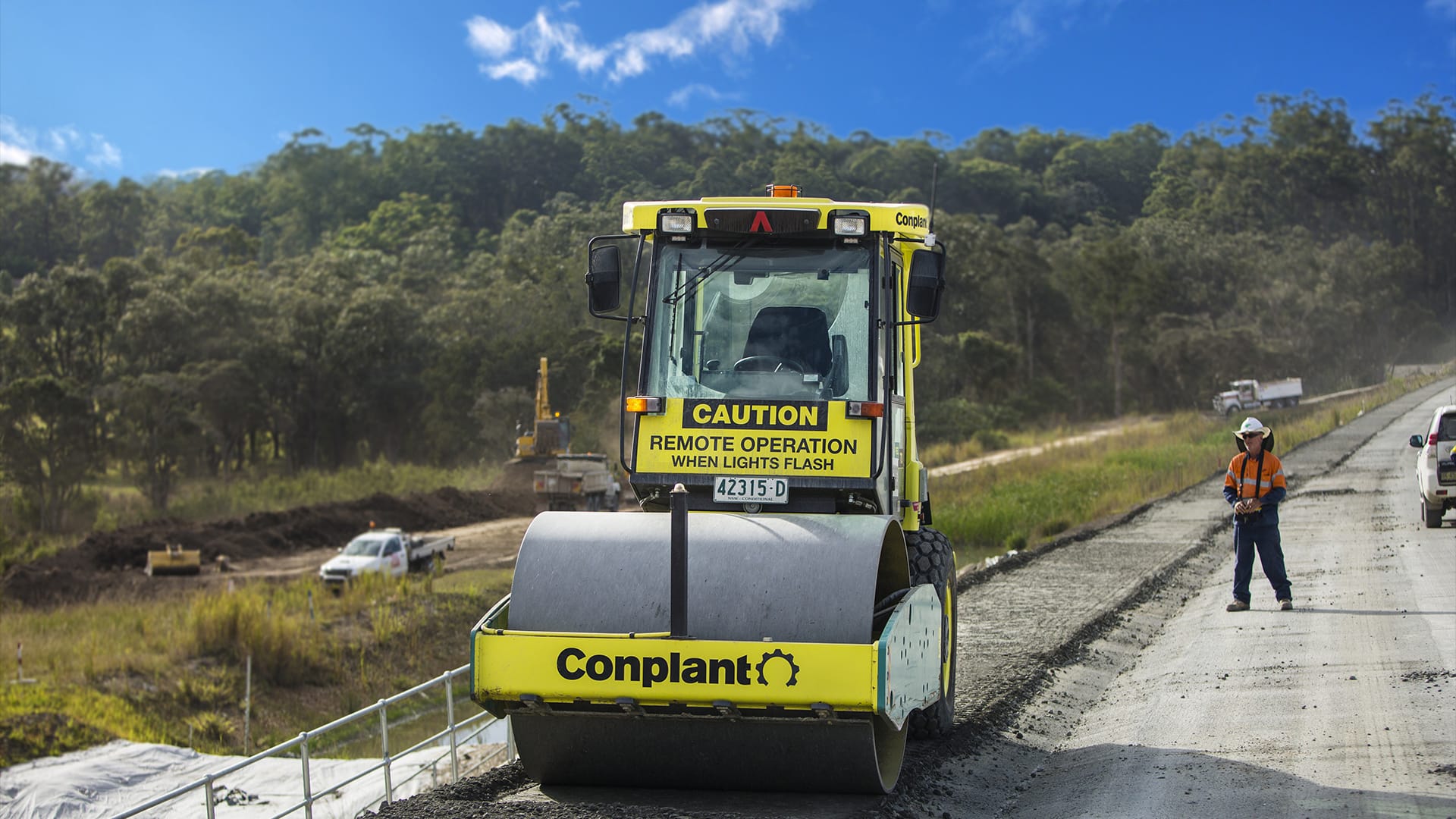The Benefits of a Site Dumper for Construction Projects
Site dumpers are a crucial part of any construction fleet. When you’re excavating, compacting, and moving earth, dumpers allow you to transport material efficiently.
Thanks to their manoeuvrability, versatility and efficiency in small spaces, site dumpers play a critical role in various industries, from construction through to agriculture and waste management. These heavy-duty machines can effortlessly move materials such as soil, gravel, and construction debris, especially in environments where space is limited or terrain is challenging.
So, what are the benefits of dumpers? What’s the difference between site dumpers and dump trucks? How are they operated? And what kinds of projects should you hire dumpers for?
Looking to hire a site dumper? Choose from our range.
Contents
What’s a dumper and what is it used for?
What are the benefits of site dumpers?
What’s a dumper and what is it used for?
A site dumper is a specialised vehicle designed for moving bulk materials around construction sites, mining operations, agricultural properties, and other industries. It typically consists of a large open skip mounted on wheels, with the ability to tilt the skip to unload its contents.
Dumpers have a powerful engine, capable of carrying large loads across uneven terrain. The design prioritises operator safety and comfort, often incorporating features such as Rollover Protective Structures (ROPS) and ergonomic seating within an enclosed cabin.

Site Dumpers are primarily used for:
- Material transport. Site dumpers are the ideal machine to carry materials such as soil, gravel, sand, rocks, debris, and construction waste on rugged terrains.
- Construction. They are commonly used in construction to move materials to and from various locations, aiding in developing roads, buildings, and infrastructure.
- Mining. In mining operations, site dumpers are used to transport extracted minerals and ore from excavation sites to processing areas or transportation vehicles.
- Agriculture. Site dumpers find applications in agriculture for tasks like transporting harvested crops, compost, or other agricultural materials.
- Waste management. Dumpers are often used to collect and transport waste and recyclable materials within waste management facilities.
Are your site dumpers in need of a tune up or running repairs? Book a service.
What are the benefits of site dumpers?
1. Increased efficiency
Using a site dumper provides a significant boost in efficiency. These robust machines are designed to transport up to 6-9t payloads quickly and effortlessly, reducing the reliance on manual labour to ultimately save time and increase overall worksite productivity. This is a massive help on big projects where time is money.
2. Versatile applications
Site dumpers are remarkably versatile. Whether you work in construction, mining, agriculture, or waste management, a site dumper can be an invaluable addition to your fleet. Their adaptability and heavy-duty skip make them suitable for a wide range of tasks, from hauling construction debris to transporting agricultural produce.
3. Enhanced safety
Equipped with safety features like seatbelts and Rollover Protection Systems (ROPS) , site dumpers ensure a secure working environment, reducing the risk of workplace accidents.
Seatbelts and Rollover Protection Systems (ROPS) are standard safety features across the Wacker Neuson DV range. Inspired by consultation with customers and extensive industry research, ROPS has won a National Safety Award and has been adopted by many industry-leading companies.
4. Cost saving
Reducing project costs is always a priority. By minimising the need for manual labour and speeding up material transportation, site dumpers help control expenses and maximise profitability.
5. Agility & site access
Compact dimensions and excellent manoeuvrability mean site dumpers can easily access areas that might be challenging for larger machinery, ensuring efficient movement on sites with limited space.
The Wacker Neuson Dual View site dumper allows operators to maintain a complete view by rotating the console 180°. Dual View technology, along with enhanced operator comfort and safety, makes the DV series ideal for stressful, tight-access jobs, including narrow roads, long single-lane roads, or railway applications.
6. Durability
Site dumpers are built to withstand the rigours of worksite conditions. Assembled with robust materials and components, they’re extremely durable in harsh Australian conditions. This longevity ensures that site dumpers are a worthwhile investment for ongoing projects.
7. Reduced environmental impact
Modern site dumpers are equipped with advanced engine technology that reduces emissions. This minimises their carbon footprint and helps to limit pollution onsite, contributing to a lower environmental impact compared to other heavy duty machinery.
8. Operator comfort
Operator comfort is a priority. Site dumpers are designed with ergonomic features such as comfortable seating, easy-to-use controls, excellent visibility, and air conditioning in an enclosed cabin. This enhances comfort, reduces fatigue, and contributes to overall safer operation.
9. Material handling
Site dumpers boast excellent flexibility both in terms of the terrain they cover as well as the material they carry – adapting to a range of onsite needs as required.
With great off-road capabilities, the Wacker Neuson Dual View dumper is ideal on wet, muddy, or sandy job sites. The DV dumper also excels in handling various types of materials, including loose soil, gravel, sand, concrete, and debris, making it an indispensable tool for a wide range of construction projects.
What’s the difference between site dumpers and dump trucks?

Site dumpers and dump trucks have distinct differences in design, capacity, and ideal use cases.
Size and capacity
- Site dumpers are smaller and have a lower capacity, typically ranging from 1-10t. They’re designed for smaller-scale operations and can navigate more easily in confined spaces or on rough terrain.
- Dump trucks are larger vehicles with a significantly higher capacity, often exceeding 10t and capable of carrying loads up to 30t. They’re suited for larger construction projects and long-distance hauling.
Manoeuvrability and adaptability
- Site dumpers’ compact size makes them more agile, better suited for navigating tight spaces and uneven terrain commonly found on construction sites.
- Dump trucks are designed for relatively smoother surfaces and may not perform as well in rough or uneven terrain compared to site dumpers. They’re more commonly used on roadways and large construction sites with enough space for manoeuvring.
Usage
- Site dumpers are ideal for small to medium-sized projects, such as home building, landscaping, and minor road works. They’re also used for moving materials over shorter distances within a construction site.
- Dump trucks are more suitable for large-scale commercial construction, mining operations, and major infrastructure projects. They are designed for transporting large quantities of materials over longer distances.
Loading and unloading
- Site dumpers usually have a front or side tipping mechanism. The smaller size allows for more precise dumping of materials.
- Dump trucks typically only have a rear tipping mechanism. Some specialised models might have side or bottom dump capabilities for specific purposes.
Design
- Site dumpers may have an open cabin or a simple protective structure for the operator, and the load-carrying skip is usually in front of the driver. However, many models also have an enclosed cabin.
- Dump trucks have a more conventional truck design with an enclosed cabin for the driver and the load-carrying bed at the back.
In summary, site dumpers are more suited for smaller-scale, more precise work in tighter or more rugged terrain, while dump trucks are geared towards heavy-duty hauling in larger construction and industrial applications.
How to choose the right site dumper
To select the right site dumper, there are three key factors to consider:
- Load capacity. Determine the maximum weight of materials you need to transport regularly. Choose a site dumper with a payload capacity that comfortably accommodates your requirements.
- Terrain compatibility. Assess the worksite terrain. If you have rugged or uneven terrain, opt for a site dumper with excellent off-road capabilities, such as the Wacker Neuson Dual-View site dumper. The dual-view operation eliminates the need to drive over tricky terrain in reverse.
- Safety features. Always prioritise safety. Ensure that the site dumper is equipped with safety features like ROPS, seatbelts, and effective braking systems to protect operators and workers on site.
The total value of new residential buildings also rose by 3.2% during this period, showing the resilience of the sector in the face of higher interest rates and economic fluctuations.
Why hire a site dumper for your next project?
Site dumpers offer a multitude of benefits that enhance efficiency, safety, and productivity on worksites. Hiring a site dumper can significantly improve operational effectiveness, offering a practical solution for diverse project requirements.
To learn more about site dumpers, or for assistance with equipment hire, get in touch with our team today.



